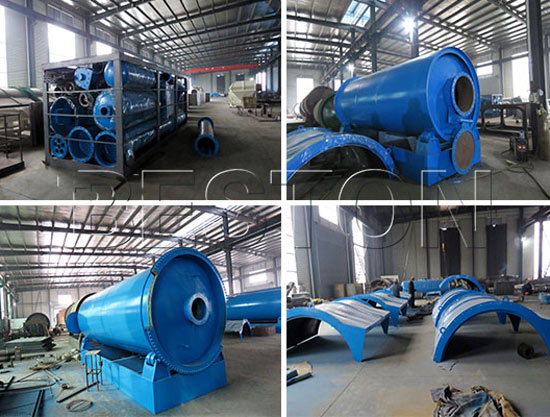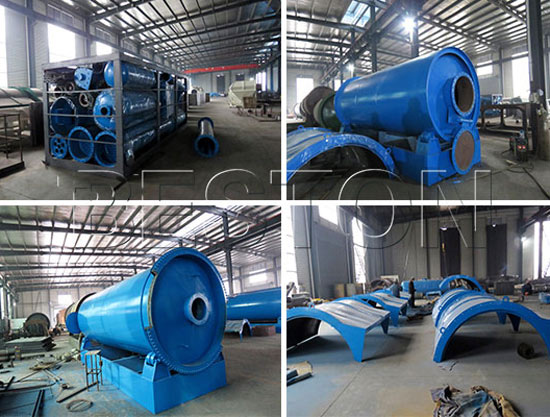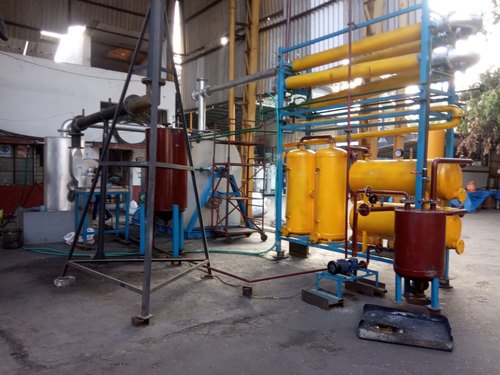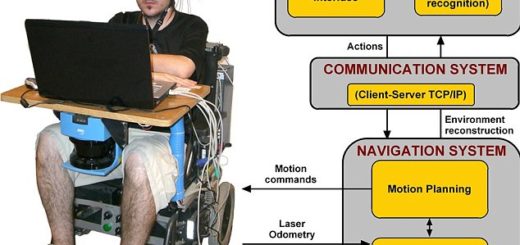Household Plastic Pyrolysis Mini Plant

1
Introduction
.1 General
The present rate of economic growth is unsustainable without saving of fossil energy like crude
oil, natural gas, or coal. There are many alternatives to fossil energy such as biomass,
hydropower, and wind energy. Also, suitable waste management strategy is another important
aspect. Development and modernization have brought about a huge increase in the production of
all kinds of commodities, which indirectly generate waste. Plastics have been one of the materials
because of their wide range of applications due to versatility and relatively low cost.
Plastic waste production and consumption is increasing at an alarming rate. Plastic waste recycling
is carried out in different ways. But in most developing countries, open or landfill disposal is a
common practice for plastic waste management. Pyrolysis is a common technique used to convert
plastic into energy, in the form of solid, liquid and gaseous fuels. Pyrolysis is defined as the
controlled heating of a material in the absence of oxygen.
In practice, it is not possible to achieve a completely oxygen-free atmosphere.
Because some oxygen will be present in any pyrolysis system; a small amount of oxidation occurs.
In plastic pyrolysis; the macromolecular structures of polymers are broken down into smaller
molecules and sometimes monomer units.
Our Project deals with the extraction of fuel from the waste plastics termed as plastic
pyrolyzed oil which can be marketed at much cheaper rates compared to that present in the
market. As we know that both Plastics and Petroleum derived fuels are Hydrocarbons that
contain the elements of Carbon & Hydrogen. Pyrolysis process becomes an option of waste-to-
energy technology to deliver bio-fuel to replace fossil fuel. The advantage of the pyrolysis process
is its ability to handle unsort and dirty plastic. The pre-treatment of the material is easy. Plastic
is needed to be sorted and dried. Pyrolysis is also nontoxic or non-environmental harmful emission
unlike incineration. Through this project we like to promote the recycling of waste Polyethylene
terephthalate (PET) bottles collected along the premises of our campus.
Literature Review
2.1 General
Literature Review is a comprehensive summary of previous research on a topic. The literature
review surveys scholarly articles, books, and other sources relevant to a particular area of research.
The review should enumerate, describe, summarize, objectively evaluate and clarify this previous
research. It should give a theoretical base for the research and help the author determine the nature
of your research. The literature review acknowledges the work of previous researchers, and in so
doing, assures the reader that your work has been well conceived.
2.2 Literature Studies
Teresa Schuberta, Markus Lehnera, Thomas Karnerb, Wolfgang Hoferc, Andrea [5]2007 –
Pyrolysis of waste plastics to recycle valuable hydrocarbons represents an attractive technology
for reducing waste and providing feed stocks for petrochemical products and fuels. Simultaneous
processing of heavy petroleum residue fractions, synergies can be harnessed by converting bottom-
of-the-barrel refining products into lighter fractions with higher value while improving process
ability of plastic waste materials To investigate the effect of reactor pressure, a continuous
laboratory co-pyrolysis plant was operated. The setup consisted of two consecutive tubular zones
to convert a mixture of LDPE and a heavy petroleum residue. Gaseous and liquid products
increased with enhanced pressure, resulting in nearly tripled gas and light liquid formation,
whereas more unconverted feed was consumed. Operation of the continuous co-pyrolysis
laboratory cracker at varied feedstock mixtures, pressure levels and residence times demonstrated
the feasibility of a simultaneous processing of LDPE and a heavy petroleum residue. Furthermore,
it emphasized the effect of experimental parameters for a successful process design and
optimization. Higher pressure levels also changed in the physical state and, therefore, the volume
of the mixture. For process design and optimization, the application of higher pressure can be
utilized to increase product yields and overall conversions. Furthermore, this study points out the
importance of including the specific reactor design to assess the possible consequences of pressure
changes validly and provide a holistic view of ongoing effects.
Objectives and Scope of the Project
3.1 Objective of the project
The objective describes an outcome, meaning the effect of change that the project is supposed to
cause for the target group. The objectives of this project are as followed:
- To check whether the process of pyrolysis is feasible or not.
- To identify the suitable type of plastic needed for the process of pyrolysis.
- To identify the suitable additives and catalysts that can be added to improve the properties
of the obtained fuel. - To develop a small-scale device to carry out pyrolysis that can be used even at small scale
house hold purposes.
3.2 Scope of the project
The Scope of study covers the upper and lower limits of the area studied from the project, and it
also defines the data and criteria that were taken as inputs. The scope of study are as followed: - In the project we are using only PET-1 type of plastic and no other types are adopted to
conduct the experiment. - We cannot ensure the maximum efficiency with the dimension used for cylinder in this
project. - In this project temperature used for the process of Pyrolysis is limited to 500 degree Celsius
because the material used to make the cylinder cannot withstand more temperature. - The energy liberated during the burning of plastics can’t be used anywhere for any other
purposes. Thus the energy liberated is wasted. - We cannot predict how effective we could conduct the process of cooling and
condensation of the fuel formed. The time taken for the project completion effectively
cannot be defined exactl
Methodology
4.1 Methodology: Pyrolysis
- Identification of waste plastics.
- Collection of plastics
- Sorting of plastics
- Shredding of plastic waste
- Developing the device
- Subjecting the waste plastic for pyrolysis process.
- Condensation of the gas to obtain raw fuel.
- Determination of calorific value of raw fuel
- Future Scope
- The fuel has to be refined at the industrial establishments, based on the results of which
- small scale industry can be established.
- As there is a high demand of crude oil and due to its sky reaching prices , we could take up
- this project to setup large or small scale industries and produce the fuel locally at much
- cheaper rates directly benefiting the National economy as well as the environment.
- The application of this project could help in reducing the dependency on the gulf countries
- and promote a step towards innovation.
- We failed in obtaining the maximum fuel content with the complete breakdown of larger
- molecules to smaller molecules,as there was leakages from various weak points of the
- container.
- The constraints can be removed by building up a well sealed leak proof container and we
- came up with a design detail of such a miniature plant.
- we can test several plastics like LDPE , PET , PVC , Teflon etc. And check their calorific
- value , octane and cetane no. etc this way we could compare the obtained fuel with the
- commercial fuel.
- After finding the values of the new fuel by adding the suitable additives we could make the
- properties of obtained fuel similar to that of a commercial fuel such that this fuel could be
- marketed in a sustainable way.

Conclusion
According to the current statistics, there is continuous rise of consumption and thus cost of
petroleum oil, International Energy Outlook 2008 reports the world consumption of
petroleum oil as 84 million barrels per day.
We concluded that fuel could be obtained by burning plastic in the absence of oxygen.
Burning plastic in an open environment produces carbon dioxide to a great extent, whereas
by burning in absence of oxygen under controlled temperature and sealed condition can
reduces 80% of carbon dioxide emissions , which results in to be quite environmental
friendly.
Through our experimentation we concluded that fuel could be obtained by burning plastic.
We also found that certain grades of plastics like PVC cannot be used for Pyrolysis as it
damages the container made of aluminium by attacking the materials.
The method of Pyrolysis can be suggested as another disposal method of plastic waste this
method can be a better alternative to incineration, as pyrolysis does not emit carbon dioxide
than incinerators and thus a useful product can be obtained.

FULL PPT AND DETAILS FOR THIS PROJECT CONTACT 7510834013(whatsaap&call)
more all branch projects and project report , contact with US


































